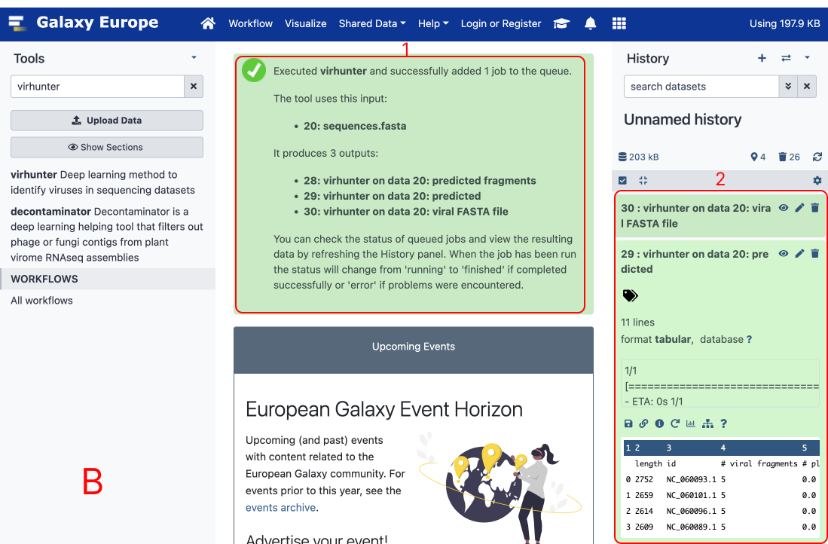VirHunter: A Deep Learning-Based Method for Detection of Novel RNA Viruses in Plant Sequencing Data
Sukhorukov, Grigorii, Maryam Khalili, Olivier Gascuel, Thierry Candresse, Armelle Marais-Colombel, and Macha Nikolski. "VirHunter: A deep learning-based method for detection of novel RNA viruses in plant sequencing data." Frontiers in Bioinformatics 2 (2022): 867111. High-throughput sequencing enables broad virus detection in various hosts. We propose a deep learning method called VirHunter to efficiently detect novel and known viruses in sequencing datasets, specifically trained for plant RNA viruses. VirHunter outperforms existing methods in detecting novel viruses in plant viromes, making it valuable for plant health diagnostics.
- 02 July 2023
- Yolanda Hernando Saiz
- < back to blog index
High-throughput sequencing has provided the capacity of broad virus detection for both known and unknown viruses in a variety of hosts and habitats. It has been successfully applied for novel virus discovery in many agricultural crops, leading to the current drive to apply this technology routinely for plant health diagnostics. For this, efficient and precise methods for sequencing-based virus detection and discovery are essential. However, both existing alignment-based methods relying on reference databases and even more recent machine learning approaches are not efficient enough in detecting unknown viruses in RNAseq datasets of plant viromes. We present VirHunter, a deep learning convolutional neural network approach, to detect novel and known viruses in assemblies of sequencing datasets. While our method is generally applicable to a variety of viruses, here, we trained and evaluated it specifically for RNA viruses by reinforcing the coding sequences’ content in the training dataset. Trained on the NCBI plant viruses data for three different host species (peach, grapevine, and sugar beet), VirHunter outperformed the state-of-the-art method, DeepVirFinder, for the detection of novel viruses, both in the synthetic leave-out setting and on the 12 newly acquired RNAseq datasets. Compared with the traditional tBLASTx approach, VirHunter has consistently exhibited better results in the majority of leave-out experiments. In conclusion, we have shown that VirHunter can be used to streamline the analyses of plant HTS-acquired viromes and is particularly well suited for the detection of novel viral contigs, in RNAseq datasets.

< back to blog index
Recent posts
- Carrot populations in France and Spain host a complex virome rich in previously uncharacterized viruses
- VIROME ANALYSIS OF IRRIGATION WATER SOURCES PROVIDES EXTENSIVE INSIGHTS INTO THE DIVERSITY AND DISTRIBUTION OF PLANT VIRUSES IN AGROECOSYSTEMS
- Round table: https://youtu.be/XPYOCrXqqOQ
- Managing the deluge of newly discovered plant viruses and viroids: an optimized scientific and regulatory framework for their characterization and risk analysis
- A new flavi-like virus identified in populations of wild carrot
- Tomato brown rugose fruit virus in aqueous environments – survival and significance of water-mediated transmission
- First report of carrot torrado virus 1 (CaTV1) naturally infecting carrots in Spain
- VirHunter: A Deep Learning-Based Method for Detection of Novel RNA Viruses in Plant Sequencing Data
- Diversity of polerovirus-associated RNAs in the virome of wild carrots
- First report of Apium virus Y in wild carrot (Daucus carota ssp. carota) in Spain
- Tobamoviruses show broad host ranges and little genetic diversity among four habitat types of a heterogeneous ecosystem.
- Metagenomics show high spatiotemporal virus diversity and ecological compartmentalisation: virus infections of melon, Cucumis melo, crops and adjacent wild communities
- Web-based roundtable: Adoption and impact of high throughput sequencing in plant health: Seed testing, surveillance and certification
- Identification of two novel putative satellite RNAs with hammerhead structures in the virome of French and Spanish carrot samples
- Diversity and pathobiology of an Ilarvirus unexpectedly detected in diverse plants and global sequencing data
- First Report of Ranunculus White Mottle Ophiovirus in Slovenia in Pepper with Yellow Leaf Curling Symptom and in Tomato
- In-depth study of tomato and weed viromes reveals undiscovered plant virus diversity in an agroecosystem
- THE EXPANDING MENAGERIE OF PRUNUS-INFECTING LUTEOVIRUSES
- Molecular characterization of a new Prunus-infecting cheravirus and complete genome sequence of stocky prune virus
- Genetic differentiation and migration fluxes of viruses from melon crops and crop edge weeds
- Global advances in tomato virome research: current status and the impact of high-throughput sequencing
- Cont-ID: Detection of samples cross-contamination in viral metagenomic data
- Validation of high throughput sequencing as virus indexing test for Musa germplasm: performance criteria evaluation and contamination monitoring using an alien control
- HIGH THROUGHPUT SEQUENCING TECHNOLOGIES COMPLEMENTED BY GROWER’S PERCEPTION HIGHLIGHT THE IMPACT OF TOMATO VIROME IN DIVERSIFIED VEGETABLE FARMS
- BIOLOGICAL AND GENETIC CHARACTERIZATION OF PHYSOSTEGIA CHLOROTIC MOTTLE VIRUS IN EUROPE BASED ON HOST RANGE, LOCATION, AND TIME
- Risk perception associated with an emerging agri-food risk in Europe: plant viruses in agriculture
- First reports of Apple luteovirus 1, Apple rubodvirus 1 and Apple hammerhead viroid infecting apples in Belgium
- Evaluation of Methods and Processing for Robust Monitoring of SARS-CoV-2 in Wastewater
- Importance of associated weeds and cropping systems in shaping the viromes of horticultural crops. Ayoub Maachi PhD Thesis
- Use of high throughput sequencing and two RNA input methods to identify viruses infecting tomato crops.
- Complete genome sequence of malva-associated soymovirus 1: a novel virus infecting common mallow
- Cohombrillo-associated virus: a novel virus infecting Ecballium elaterium plants
- Known and new viruses identified in the virome of crops scanned by INEXTVIR
- Scanning the virome of Prunus : Identification and characterization of novel luteoviruses and Secoviridae members
- Complete genome sequence of almond luteovirus 1, a novel luteovirus species infecting almond
- INEXTVIR Mid-Term Check + Network Meeting 2 + School 2